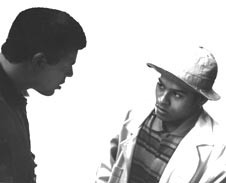
A Walk in the Night 1998
Distributed by California Newsreel, Order Dept., PO Box 2284, South Burlington, VT 05407; 877-811-7495 (toll free)
Produced by Interface Productions, in association with SABC 1 and the Dept. of Arts and Culture
Director n/a
VHS, color, 78 min. ( 3 segments, 26 min. each)
Adult
Multicultural Studies, Psychology, Political Science, Sociology
Date Entered: 11/09/2018
Reviewed by Thomas J. Beck, Auraria Library, University of Colorado at DenverThis film is a fictional story, which nevertheless gives the viewer a realistic, and often times frightening, portrayal of life in modern South Africa. It centers on a young steelworker of mixed race named Mikey. Mixed race people in South Africa are commonly referred to as "Coloured", and are considered a separate racial group. They are frequently spurned by both the country's Black and White populations, and generally live in poverty. Mikey has a deep and palpable resentment toward other racial groups, especially Whites, and a general disdain for South African society. He dreams of leaving his homeland and moving to America.
At the beginning of the film, he is fired from his job by a racist, white supervisor for going to the restroom before his scheduled break time. Desperate for work, he agrees to become a courier for a local drug dealer. At roughly the same time he and his girlfriend Zelda go through an ugly break up, due to his unwillingness to make a commitment to either her or their unborn child. Zelda's young brother Joey, works as a prostitute so as to put food on the table, and is involved in a local street gang. Mikey tries unsuccessfully to keep Joey away from a life of crime, but is more often then not preoccupied with his own problems, particularly his growing resentment toward society. Mikey's anger and disillusionment increase visibly as the film progresses, and are punctuated by run-ins with both a racist policeman and a gang leader. His alienation is frequently expressed to the viewer through quotes from Shakespeare's Hamlet. All of these deal with suicide and revenge, and most are spoken by an old white man named Uncle Doughty. Doughty is an alcoholic, former lover of Mikey's mother, who prefers to wile away his time by quoting the "Bard" to Mikey in a local tavern.
In the end Mikey's anger gets the best of him, and in a drunken fit of rage he sets a series of events into motion that eventually have tragic consequences for both himself and those he loves.
The technical qualities of the film are quite good. Audio, video and editing are well done. Some may find the video a bit grainy, but I think that adds to the gray, gritty atmosphere that the film wants to project. It is intended for mature audiences, and only for those who are comfortable with reading frequent sub-titles (Mikey and his friends usually speak in Africaans, the language most frequently used by Coloureds, and not in English). There is no overt sexual activity, but it is often alluded to, and there is a good deal of drinking and violence as well. Racial epithets are frequently used, though in South African slang which may be unknown (and is possibly inoffensive) to most Americans. Some prior knowledge of South African society will be helpful to the viewer, but is not necessary. Graduate and undergraduate programs dealing with African or ethnic studies, sociology, psychology or political science will find this film the most useful. It relates in one way or another to all of them.
This film is an excellent portrayal of the racial tension and economic despair that still permeates South Africa. It is highly recommended.